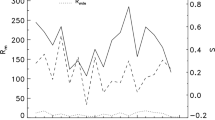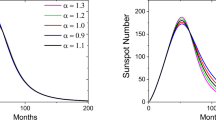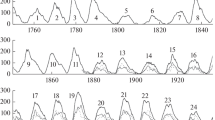Abstract
We propose a simple method based on two relations for predicting the maximum of an 11-year solar cycle. The first relation is the well-known Waldmeier rule that binds the amplitude of a cycle and the length of its ascending phase. The second one relates the length of a given cycle from minimum to minimum and the amplitude of the next one. Using corresponding linear regressions, we obtain for the amplitude of Cycle 25 in the scale of 13-month smoothed monthly total revised sunspot number \({\mathrm{SN}}_{\mathrm{max}}(25) = 181\pm 46\) and for the moment of the maximum \(t_{\mathrm{max}}(25) = 2024.2\pm 1.0\). Therefore, according to the prediction, Cycle 25 will be higher than the previous one (\({\mathrm{SN}}_{\mathrm{max}}(24) = 116\)) with probability 0.92.







Similar content being viewed by others
Data Availability
The datasets analysed during the current study are publicly available on resources referenced above. The datasets generated during the study are available from the author on reasonable request.
Notes
The dataset is available at https://wwwbis.sidc.be/silso/DATA/SN_ms_tot_V2.0.txt.
References
Booth, R.J.: 2021, Limitations in the Hilbert transform approach to locating solar cycle terminators. Solar Phys. 296, 108.
Burud, D.S., Jain, R., Awasthi, A.K., Chaudhari, S., Tripathy, S.C., Gopalswamy, N., Chamadia, P., Kaushik, S.C., Vhatkar, R.: 2021, Spotless days and geomagnetic index as the predictors of solar cycle 25. Res. Astron. Astrophys. 21, 215.
Chernosky, E.J.: 1954, A relationship between the length and activity of sunspot cycles. Publ. Astron. Soc. Pac. 66(392), 241.
Clette, F., Svalgaard, L., Vaquero, J.M., Cliver, E.W.: 2014, Revisiting the sunspot number. Space Sci. Rev. 186, 35.
Courtillot, V., Lopes, F., Le Mouël, J.L.: 2021, On the prediction of solar cycles. Solar Phys. 296, 21.
Du, Z.L.: 2022, The solar cycle: a modified Gaussian function for fitting the shape of the solar cycle and predicting cycle 25. Astrophys. Space Sci. 367, 20.
Gnevyshev, M.N., Ohl, A.I.: 1948, On 22-year cycle of the solar activity. Astron. Zh. 25, 18.
Hathaway, D.H.: 2015, The solar cycle. Living Rev. Solar Phys. 12, 4.
Hathaway, D.H., Wilson, R.M., Reichmann, E.J.: 1994, The shape of the sunspot cycle. Solar Phys. 151, 177.
Ivanov, V.: 2021, Two links between parameters of 11-year cycle of solar activity. Geomagn. Aeron. 61, 1029.
Koutchmy, S., Tavabi, E., Noëns, J.-C., Wurmser, O., Filippov, B.: 2021, Predicting the height of the solar cycle 25 through polar regions activity. In: Siebert, A., et al. (eds.) Proceedings of the Annual Meeting of the French Society of Astronomy and Astrophysics, 238.
Leamon, R.J., McIntosh, S.W., Chapman, S.C., Watkins, N.W.: 2021, Response to “Limitations in the Hilbert transform approach to locating solar cycle terminators” by R. Booth. Solar Phys. 296, 151.
Lu, J.Y., **ong, Y.T., Zhao, K., Wang, V., Li, J.Y., Peng, G.S., Sun, M.: 2022, A novel bimodal forecasting model for solar cycle 25. Astrophys. J. 924, 59.
McIntosh, S.W., Chapman, S.C., Leamon, R.J., Egeland, R., Watkins, N.W.: 2020, Overlap** magnetic activity cycles and the sunspot number: forecasting sunspot cycle 25 amplitude. Solar Phys. 295, 163.
Nandy, D.: 2021, Progress in solar cycle predictions: sunspot cycles 24-25 in perspective. Solar Phys. 296, 54.
Sachs, L.: 1972, Statistische Auswertungsmethoden, Springer, Berlin.
Solanki, S.K., Krivova, N.A., Schüssler, M., Fligge, M.: 2002, Search for a relationship between solar cycle amplitude and length. Astron. Astrophys. 396, 1029.
Prasad, A., Roy, S., Sarkar, A., Chandra Panja, S., Narayan Patra, S.: 2022, Prediction of solar cycle 25 using deep learning based long short-term memory forecasting technique. Adv. Space Res. 69, 798.
Waldmeier, M.: 1935, Neue Eigenschaften der Sonnenfleckenkurve. Astron. Mitt. Eidgenöss. Sternwarte Zür. 14, 105.
Wu, S.-S., Qin, G.: 2021, Predicting Sunspot Numbers for Solar Cycles 25 and 26. E-print. ar**v.
Author information
Authors and Affiliations
Corresponding author
Ethics declarations
Disclosure of Potential Conflicts of Interest
The authors declare that they have no conflicts of interest.
Additional information
Publisher’s Note
Springer Nature remains neutral with regard to jurisdictional claims in published maps and institutional affiliations.
Rights and permissions
About this article
Cite this article
Ivanov, V.G. Solar Cycle 25 Prediction Using Length-to-Amplitude Relations. Sol Phys 297, 92 (2022). https://doi.org/10.1007/s11207-022-02031-3
Received:
Accepted:
Published:
DOI: https://doi.org/10.1007/s11207-022-02031-3




